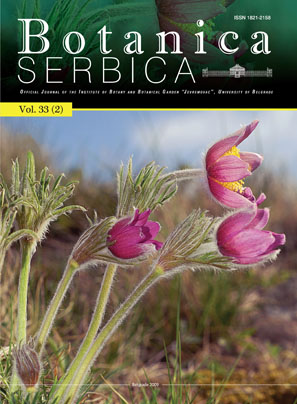
Volume 33 Issue 2 2009 |
|
Southern European species in the flora of towns in the central Poland WITOSLAWSKI P & BOMANOWSKA A. Pages 115-129 Full reference | Abstract | Full text PDF |
KEY WORDS: urban flora, southern European plants, synanthropization, central Poland |
|
A Web-Enabled Interactive Application for the Development of a Knowledge Base on Greek Flora KONSTANTINOU M, PALIOKAS I, IAKOVOGLOU V, SARIKOU S, CHATZIPHILIPPIDIS G & ELEFTHERIADIS N. Pages 131-136 Full reference | Abstract | Full text PDF |
KEY WORDS: Flora Database, Web Services, Landscape Architecture, Ornamental Plants, Greece. |
| Axenically culturing the bryophytes: a case study of the moss Dicranum scoparium Hedw. (Dicranaceae, Bryophyta) VUJICIC M, SABOVLJEVIC A & SABOVLJEVIC M. Pages 137-140 Full reference | Abstract | Full text PDF |
KEY WORDS: moss, Dicranum scoparium, in vitro, axenical culture |
| On the position of the tribe Eritrichieae in the Boraginaceae system OVCHINNIKOVA S. Pages 141-146 Full reference | Abstract | Full text PDF |
KEY WORDS: Boraginaceae, tribe Eritrichieae, phylogenetic system, evolution, primary sculpture of nutlets. . |
| Endemic plants of Basarakavak and environs (Konya, Turkey) YILDIZTUGAY, E, BAGCI, Y &KÜÇÜKÖDÜK M Pages 147-155 Full reference | Abstract | Full text PDF |
KEY WORDS: Flora, Endemic, Basarakavak, Tatköy, Altinapa Dam, Konya, Turkey |
| In vitro culture of Balkan endemic and rare Pulsatilla species for conservational purposes and secondary metabolites production DANOVA K, BERTOLI A, PISTELLI L, DIMITROV D & PISTELLI L. Pages 157-162 Full reference | Abstract | Full text PDF |
KEY WORDS: Pulsatilla montana ssp. balcana, P. halleri ssp. rhodopaea, P. slaviankae (Zimm.) Jordanov & Kozuharov, shoot cultures, antioxidant phenolics, photosynthetic pigments |
| Structural responses of the photosynthetic apparatus of Orthosiphon stamineus Benth. to temperature stress aft er cryopreservation GANEVA T, STEFANOVA M, CELLÁROVÁ E, UZUNOVA K& KOLEVA D. Pages 163-167 Full reference | Abstract | Full text PDF |
KEY WORDS: cryopreservation, structure, tissues, cuticle, Orthosiphon stamineus |
| Forest fires - ecological and economic problem in Serbia ALEKSIC P, KRSTIC M & JANCIC G. Pages 169-176 Full reference | Abstract | Full text PDF |
KEY WORDS: Forest fires, Serbia, ecological consequences, economic consequences |
| Floristic and chorological news from north Albania RAKAJ M. Pages 177-183 Full reference | Abstract | Full text PDF |
KEY WORDS: New floristic and chorological additions, North Albania, Bjeshkët e Nemuna (Prokletije), Mt Pashtrik. |
| The biological evidence of climate changes: a case study of liverwort Lunularia cruciata (L.) Dum. ex Lindb. in Serbia SABOVLJEVIC M & MARKA J. Pages 185-187 Full reference | Abstract | Full text PDF |
KEY WORDS: |


